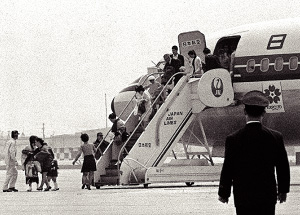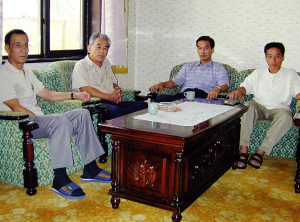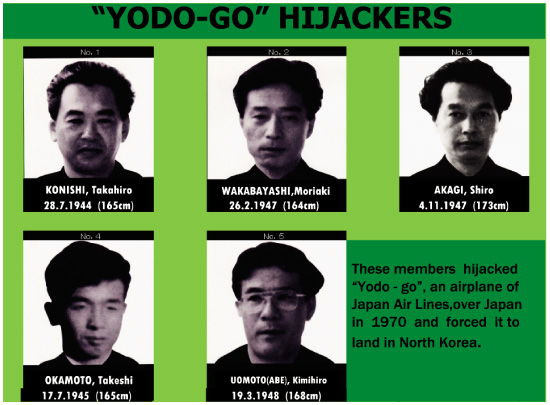1. The Hijacking of the "Yodo-go" and the Movements of the "Yodo-go" Group
The hijacking of the "Yodo-go" took place on March 31, 1970, when nine members of "KYOSANDO SEKIGUNHA,"
or the Red Army Faction of the Communist League, armed with Japanese swords, steel pipes, and bombs
hijacked Japan Airlines Flight 351 from Tokyo to Fukuoka, commonly known as the "Yodo-go." They took a total
of 129 hostages, including 122 passengers and seven crew members, and demanded that the plane be taken
to North Korea. After releasing some of the hostages at Fukuoka Airport and some at South Korea's Kimpo
Airport, the plane eventually landed in Mirim Airport in North Korea on April 3 where the hijackers surrendered
themselves to the North Korean authority.
The police placed these "Yodo-go" hijackers on the international wanted list through Interpol, and in May 1988 arrested one of them who had been hiding in Japan using an illegally-obtained passport. Furthermore, Yoshimi Tanaka was arrested by Thai authorities and turned over to the custody of the Japanese police in March 2000. In addition, the deaths of two other hijackers in North Korea, including the leader, Takamaro Tamiya, have already been confirmed. Therefore, it is assumed that the following five are currently residing in North Korea: Takahiro Konishi, Shiro Akagi, Kimihiro Uomoto (former surname: Abe), Moriaki Wakabayashi, and Takeshi Okamoto. (One of them is said to be dead, but this has not been confirmed.)
At the same time, there were six suspicious Japanese women who had been in contact with Nor th Korean agents in Europe throughout the 1980s. To restrict their activities overseas in the interest of preventing terrorism, MOFA ordered them to turn in their passports in August 1988.
It was found in 1992 that all of these women were wives (one of them was the ex-wife) of the "Yodogo" hijackers. The police have placed the five women who disobeyed the order to return their passports, excluding the ex-wife, on the international wanted list for suspected violation of the Passport Law.
The "Yodo-go" group continues to actively asser t its position through organizational publications, the Internet, and other media from North Korea, based on its close relationship with the North Korean authority. It has made the return of every member to Japan its priority.
The "Yodo-go" hijackers have been making an appeal through organizational publications for an agreement to allow the early return of all of them to Japan, and there is a movement toward this end. In June 2004, they sent a letter to the North Korean authority requesting assistance for their return to Japan. In response, the authority reiterated their position that they would not oppose their return to Japan.
Regarding the wives of the "Yodo-go" hijackers and other group members, by 2003 three have returned to Japan and have been arrested. Tamiko Uomoto, who had been placed on the international wanted list for suspected Passport Law violations as well as forgery and use of signed or sealed private documents (as she allegedly opened a bank account using a false name), was arrested in February 2004 upon her return to Japan. In October of the same year, Kyoko Tanaka, who had been on the international wanted list for Passport Law violation, was also arrested upon her return. Regarding their children, seventeen have returned to Japan so far.
 |
| Hostages leaving the Japan Airline "Yodo-go" at the Fukuoka Airport (March 1970) (Photo: Kyodo Press) |
 |
| "Yodo-go" hijackers being interviewed by the media in Pyongyang (From left to right: Kimihiro Uomoto, Takahiro Konishi, Shiro Akagi, Moriaki Wakabayashi) (September 2004) (Photo: Kyodo Press) |
In March 2002, the ex-wife of the "Yodo-go" hijacker testified that she had been given orders by their leader, Takamaro Tamiya, who had been instructed by then President Kim Il-Sung of North Korea, to "realize a revolution passed down through the generations." She said she had approached and deceived Keiko Arimoto, who was studying in London in 1983, and brought her to Kim Yu-Chol of the Korean Workers' Party (KWP), and Kimihiro Uomoto in Copenhagen, Denmark who was taken to Nor th Korea. As a result of comprehensively examining this testimony and other findings collected thus far, the police have concluded that the "Yodogo" group was deeply involved in the abduction of Japanese nationals under the direction of the KWP, with the aim of implementing a Japanese revolution based on Kim Il-Sung's doctrine.
The police obtained an arrest warrant for Kimihiro Uomoto in September 2002 and have placed him on the international wanted list for the suspected kidnapping of Keiko Arimoto for the purpose of marriage.
 |
| "Yodo-go" hijackers currently placed on the international wanted list by Japan |